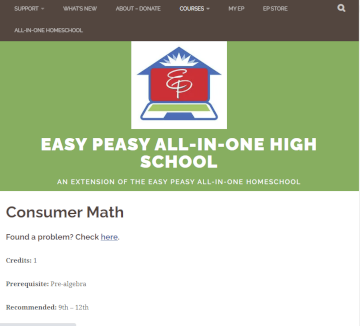Consumer Math is a free, online course for high school students, available through Easy Peasy. Lessons are planned for a 180-day schedule, and the only prerequisite is a pre-algebra course.
The course uses three online sources for most of the lesson material. Math and You: The Power & Use of Mathematics is used for the first half of the course. My Classroom’s Consumer Math textbook provides most of the content for the second half, supplemented by lessons from Next Gen Personal Finance (ngpf). Occasional links to other websites are included for videos, articles, activities, and optional games.
The website says that students can use either half of the course alone for a one-semester course. The first half covers both consumer math and practical applications of math, while the second course focuses more narrowly on consumer math. The first nine chapters from the first coursebook, Math and You, are completed in the first semester, and chapter 10 kicks off the second semester. So, if you want a one-semester course, you should probably use the lessons up through Lesson 100 or begin with Lesson 101. (There are 179 lessons in all.)
For most lessons, Easy Peasy lists course assignments and links to pages from the textbooks for students to read. Students need to solve problems on the textbook pages offline and write their answers so that parents can check them. The lessons direct students to go back and try to fix problems they missed, figuring out where they went wrong. This is important to ensure students master each concept.
Parents have a password that allows them to access answers. Scores should be recorded on the downloadable grading sheets or Excel spreadsheet.
Parents should create a free “MY EP” account that will track progress through the course, although it does not track scores. (Donations to help fund the website are welcomed.) Students can use course material without an account, but I don’t see any reason not to create one.
Math and You
The textbook, Math and You: The Power & Use of Mathematics, is displayed a page at a time online through the Easy Peasy course, but you can purchase a printed book through Amazon.
This full-color, 499-page textbook explains concepts and walks students through a sample problem before presenting a practice problem. The problems are based on practical applications, such as comparing the annual cost of gas for two different cars and predicting the recovery pattern for nesting pairs of bald eagles based on years of observational data. The focus is on the many ways math is used rather than just consumer math, and this is reflected in the titles of the book’s 10 chapters:
- Calculation
- Consumption
- Logic & the Media
- Inflation & Depreciation
- Taxation
- Borrowing & Saving
- Patterns & Nature
- Likelihood
- Description
- Fitness and Sports Credits
The problems are challenging with multiple steps. When there are sets of problems, Easy Peasy often assigns only the odd-numbered problems since many of them will take quite a bit of time to solve. The textbook includes chapter reviews but no cumulative reviews or exams that cover the entire course.
My Classroom’s Consumer Math
Easy Peasy’s course uses nine of this textbook’s 11 chapters:
- Gross Income
- Net Income
- Recordkeeping
- Checking Accounts
- Savings Accounts
- Cash Purchases
- Charge Accounts and Credit Cards
- Loans
- Vehicle Transportation
The last two chapters on housing costs and insurance can be accessed at My Classroom’s site, but other topics have been added to the course in their place. Those topics include budgeting (including housing and automotive costs), cryptocurrency, business plans, freelancing, values and money management, financial scams, the influence of social media, altruism and charity, college funding, college alternatives, and workplace ethics.
The Easy Peasy course emphasizes that credit cards should never be used to maintain balances but should be paid off immediately and that debt should generally be avoided. Extra lessons on credit card debt and predatory lending help students understand the problems associated with interest-bearing debt.
The textbook includes vocabulary words, explanations of new concepts and skills, worked-out example problems, and plenty of practice problems. Among the practice problems are plenty of word problems as well as sets of straightforward math problems that help students retain skills. As with the other textbook, Easy Peasy often assigns only selected problems from the sets. Each chapter has review exercises, a large set of end-of-chapter “assessment problems, and a “Cumulative Test Prep” section with multiple-choice questions, short-answer questions, and others that require written explanations.
Students are often assigned a few sections within a chapter for a single lesson, although this might be more work than they can complete in one day.
As I mentioned at the beginning of this review, some lessons refer students to videos and other online content, primarily from ngpf. For example, students watch a video about car loans, then use an online auto loan calculator at ngpf to complete an interactive chart to discover the total cost of a car loan depending upon the monthly payment. Occasionally, lessons direct them to other sites for YouTube® videos, such as one on Responsible Borrowing, and articles, such as “Interest Rates and Fees for Federal Student Loans.”
Summary
Easy Peasy has done a great job of collating resources to put together this course. While there is some overlap between the two textbooks, they approach the topics from different directions. The inclusion of videos, interactive online websites, games, and articles on additional topics make the course both more practical and more interesting than most consumer math textbooks. However, I think the amount of material per lesson might need some adjusting, and students might need to skip some topics if they run short of time.









